Huawei P10 and P10 Plus: Performance & Battery Life Report
by Matt Humrick on May 12, 2017 7:00 AM ESTGPU & Gaming Performance
Previous Kirin SoCs, including the Kirin 955 inside last year’s P9, used smaller GPUs with fewer cores, effectively capping peak performance well below competing flagship phones. The Kirin 960 SoC inside the P10, P10 Plus, and Mate 9 breaks this trend, however. It uses a Mali-G71MP8 GPU based on ARM’s new Bifrost architecture, and while it still processes 1 pixel/texel per clock per core and up to 12 FP32 FMAs per core like the Mali-T880MP4 Midgard GPU in the P9’s Kirin 955 SoC, it uses twice as many cores, giving it a significant advantage in both ALU and texturing throughput.
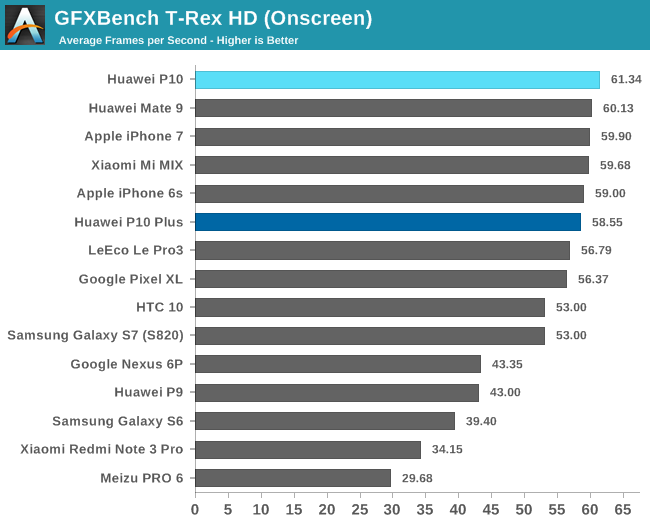
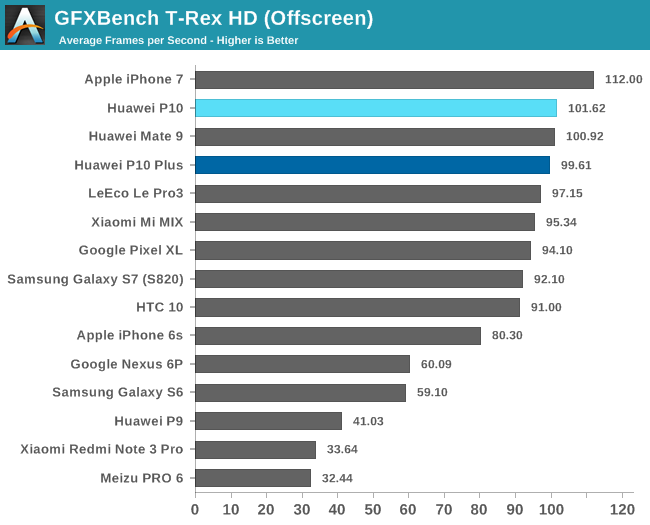
Like most flagship phones today, the P10 has no trouble hitting the 60fps V-Sync limit in the older OpenGL ES 2.0-based GFXBench T-Rex game simulation. Even the P10 Plus with its higher 2560x1440 native resolution averages close to 60fps. When running offscreen at a fixed 1080p resolution, both P10s and the Mate 9 achieve the same score (as expected), which is comparable to phones running Snapdragon 820/821 SoCs.
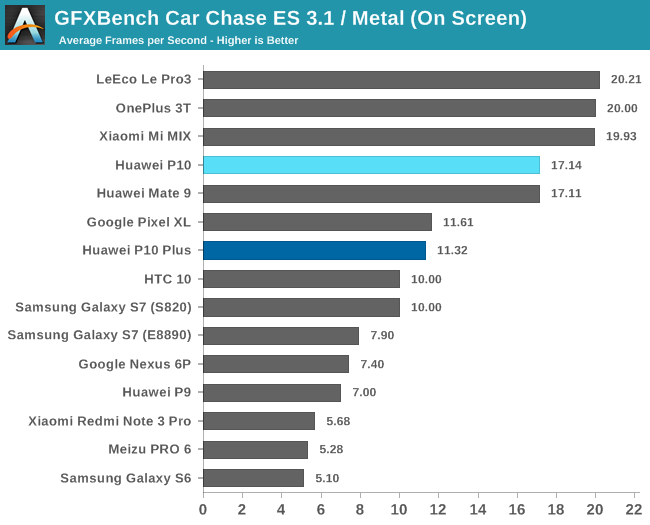
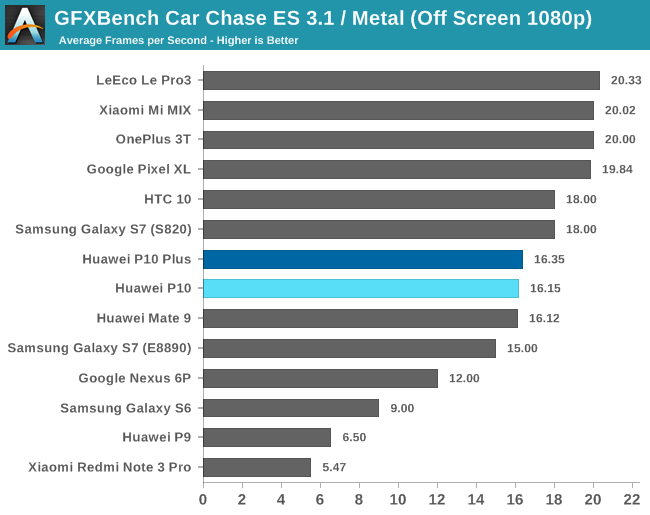
The GFXBench Car Chase game simulation uses a more modern rendering pipeline and the latest features, including tessellation, found in OpenGL ES 3.1 plus Android Extension Pack (AEP). Like many current games, it stresses ALU performance to deliver advanced effects.
Focusing on the offscreen results, there’s no surprises among the phones with Kirin 960. The P10 is about 2.5x faster than the P9, which is a little more than the difference in core count and GPU frequency alone can account for. I noted in the Mate 9 review that one of the biggest changes between ARM’s Midgard and Bifrost architectures is the move away from shader cores that use an SIMD ISA and rely on Instruction Level Parallelism (ILP) to shader cores with a scalar ISA that rely on Thread Level Parallelism (TLP). This change helps Bifrost improve shader core utilization, because it’s much easier to extract TLP from modern game workloads.
These architectural improvements help the P10’s Mali-G71MP8 GPU outpace the older but larger Mali-T880MP12 GPU in the Galaxy S7’s Exynos 8890 SoC, although the P10’s significant frequency advantage (1037MHz vs 650MHz for the S7) also plays a significant role. In this particular ALU-heavy workload, the Adreno 530 GPU in Qualcomm’s Snapdragon 820/821 SoC still comes out on top, however. The LeEco Le Pro3, OnePlus 3T, and Pixel XL all use a newer GPU driver, which allows them to pull ahead of the other Snapdragon 820 phones.
In the onscreen test, the Le Pro3, OnePlus 3T, and Mi MIX, come out on top by combining a Snapdragon 820/821 SoC with slightly lower resolution 1080p displays. The P10 and Mate 9 also have fewer pixels to render than the 1440p P10 Plus, giving them a 51% advantage here.
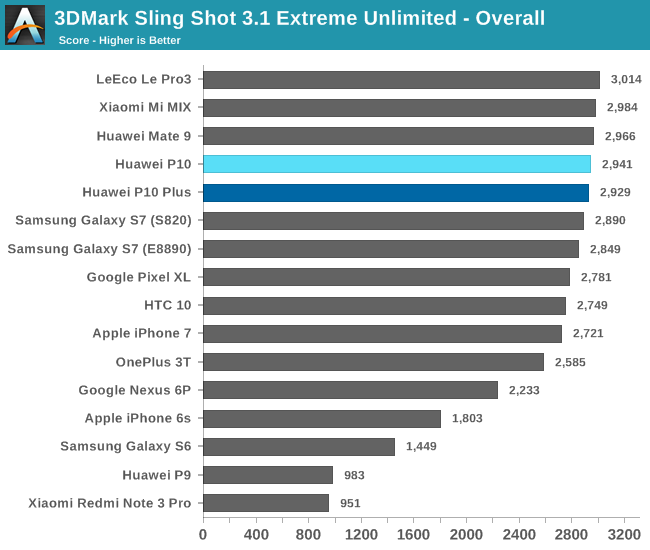
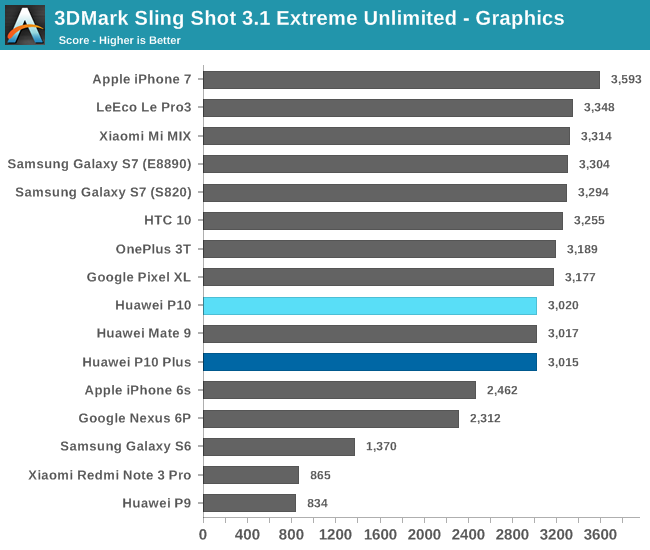

3DMark Sling Shot Extreme uses either OpenGL ES 3.1 on Android or Metal on iOS and stresses the GPU and memory subsystems by rendering offscreen at 1440p (instead of 1080p like our other tests).
There’s only a 17% performance spread across current generation flagship phones, from the LeEco Le Pro3 to the OnePlus 3T, based on the overall score. ARM’s new Bifrost architecture sees an even bigger jump in the 3DMark Sling Shot graphics workloads, showing an 86% improvement over the Midgard GPU architecture in the P9 after applying a 2x scale factor to simulate the difference in core count. There’s still a small 10% gap between the P10 and the Snapdragon 820/821 phones, which get most of their advantage in the second graphics test that emphasizes pixel rather than geometry processing.

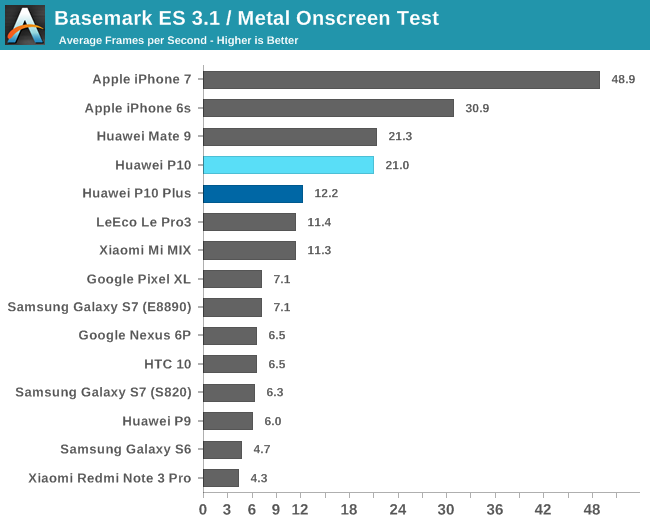
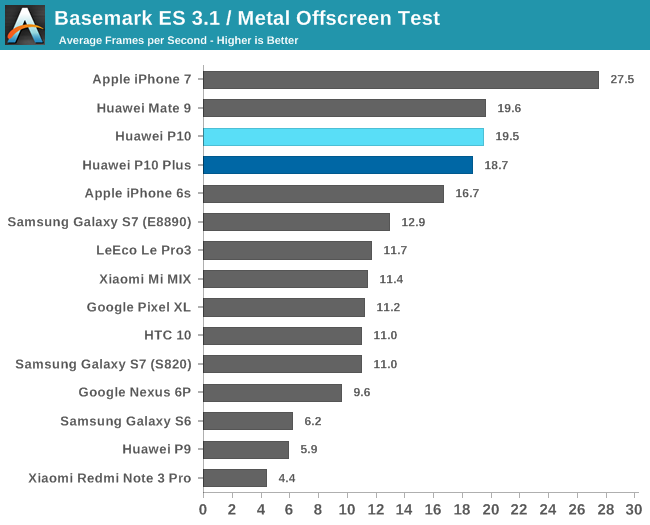
The demanding Basemark ES 3.1 game simulation uses either OpenGL ES 3.1 on Android or Metal on iOS. It includes a number of post-processing, particle, and lighting effects, but does not include tessellation like GFXBench 4.0 Car Chase.
The iPhone 7 takes advantage of Apple’s Metal graphics API, which dramatically reduces driver overhead when issuing draw calls, to pull ahead of the Android phones that are still using OpenGL in this test. While the P10s support Vulkan, a new low-level graphics API that has similar benefits to Apple’s Metal, benchmark and game support is taking longer to materialize. We should see it in action later this year, though.
The two P10s do very well in this test, placing ahead of the Exynos 8890 version of the Galaxy S7 by 52% and the Snapdragon 820 version by 78%. Even though we’ve seen the Adreno 530 GPU perform well in our other tests, it’s interesting to see it fall behind the Mali GPUs in this workload.
As expected, both the P10 and P10 Plus perform just as well as the Mate 9, all of which are using LPDDR4 RAM. Doubling the number of shader cores and switching from the Midgard to the Bifrost GPU architecture significantly improves peak performance over the previous generation, and puts the P10 in the same league as other current flagship phones.










74 Comments
View All Comments
Eden-K121D - Friday, May 12, 2017 - link
It is very hypocritical of a company when they market a Product as a flagship but don't hold them to the same standard. It is very bad that they mislead customers about very much slower emmc and then make rubbish claims of optimization.BurntMyBacon - Friday, May 12, 2017 - link
Roughly equivalent or perceptually equivalent is one thing. Clearly different, as is the case with the flash here, is unquestionably unacceptable. Guess I can mark Huawei off my list of manufacturers to follow.niva - Friday, May 12, 2017 - link
The only Huawei I wanted to buy was the Nexus 6P, and only because Google was in charge of the software running on it. Otherwise I'm really not interested in any Chinese phones, this may be generally true for any non Nexus/Pixel phones but the Chinese have earned a special disdain from me many years ago with their practices/software.So no... I'm not interested in this phone. If you gave me one I'll go ahead and try to sell it immediately.
AlphaBlaster - Sunday, May 14, 2017 - link
Who writes this innocuous crap? "Trump is ruining his political career?" Trump doesn't have a political career. He is a circus clown told what to say by the wealthy few who are running everything, own everything! They put a magpie frontman in that position to guarantee that their status quo is maintained and increases , by design, to their benefit alone, and to the oppression, impoverishment, and murdering of everybody else. "Providing context?" On what? At this stage of the game, the only 'context' any legitimate person should be engaged in is guerilla warfare!kaidenshi - Sunday, May 14, 2017 - link
Did you mix up your AnandTech and Facebook tabs?leexgx - Friday, May 12, 2017 - link
This reminds me of Kingston using different flash that is far slower but nothing on the box to state what it is (only find out when you used it for a bit or do benchmark testss.yu - Saturday, July 29, 2017 - link
If they didn't advertise about specific technology or a specific performance standard the product should reach then you can't fault them, not the case for Huawei.boozed - Monday, May 15, 2017 - link
Did we read the same review?s.yu - Saturday, July 29, 2017 - link
Nice to see more people agreeing with what I've been saying for literally years(since P8), I guess it's inevitable that more discerning customers will come to realize Huawei's deceptive nature as they expand their businesses beyond China. I honestly hope that a company like this would crash into the ground real soon, but I just don't think most of the consumer market is knowledgeable and principled enough for that to happen.virtuastro - Friday, May 12, 2017 - link
I'm glad you said that it's smooth and responsive but not Pixel XL smooth. It's good to know. I want to see how P10/ P10 Plus's camera image quality. But I did saw dxomark review about it.